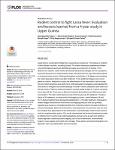Rodent control to fight Lassa fever: Evaluation and lessons learned from a 4-year study in Upper Guinea
Saez, Almudena Mari
Haidara, Mory Cherif
Camara, Amara
Kourouma, Fodé
Sage, Mickaël
Magassouba, N'Faly
Fichet-Calvet, Elisabeth
Lassa fever is a viral haemorrhagic fever caused by an arenavirus. The disease is endemic in West African countries, including Guinea. The rodents Mastomys natalensis and Mastomys erythroleucus have been identified as Lassa virus reservoirs in Guinea. In the absence of a vaccine, rodent control and human behavioural changes are the only options to prevent Lassa fever in highly endemic areas. We performed a 4 year intervention based on chemical rodent control, utilizing anticoagulant rodenticides in 3 villages and evaluating the rodent abundance before and after treatment. Three additional villages were investigated as controls. Analyses to assess the effectiveness of the intervention, bait consumption and rodent dynamics were performed. Anthropological investigations accompanied the intervention to integrate local understandings of human–rodent cohabitation and rodent control intervention. Patterns of bait consumption showed a peak at days 5–7 and no consumption at days 28–30. There was no difference between Bromadiolone and Difenacoum bait consumption. The main rodent species found in the houses was M. natalensis. The abundance of M. natalensis, as measured by the trapping success, varied between 3.6 and 16.7% before treatment and decreased significantly to 1–2% after treatment. Individuals in treated villages welcomed the intervention and trapping because mice are generally regarded as a nuisance. Immediate benefits from controlling rodents included protection of food and belongings. Before the intervention, local awareness of Lassa fever was non-existent. Despite their appreciation for the intervention, local individuals noted its limits and the need for complementary actions. Our results demonstrate that chemical treatment provides an effective tool to control local rodent populations and can serve as part of an effective, holistic approach combining rodent trapping, use of local rodenticides, environmental hygiene, house repairs and rodent-proof storage. These actions should be developed in collaboration with local stakeholders and communities.
Dateien zu dieser Publikation

